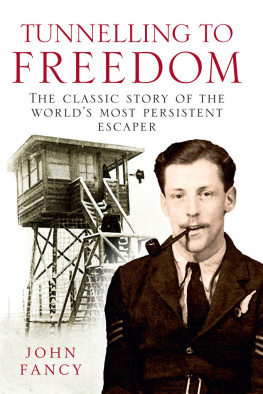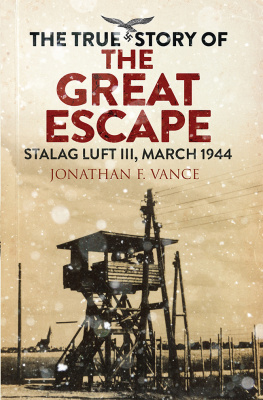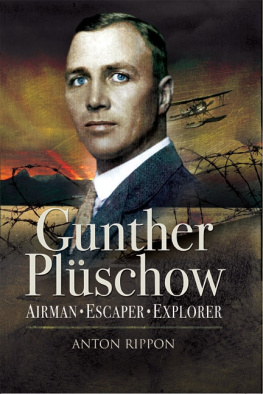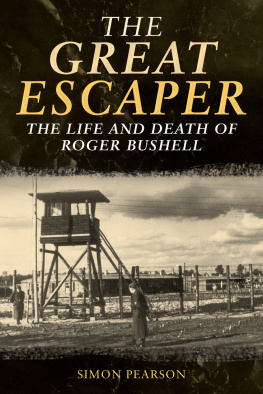The cell doors were flung open and we were marched out into the prison yard to find six guards lined up with rifles. We continued our march in single file to the far end and halted with our backs to the wall, facing the riflemen.
I thought of the little baby I had never seen ... of the thousand and one things I wanted to tell my wife.
Chins up, whispered Neil.
I prepared myself for the awful, red-hot, sizzling, sudden pain of the crashing bullet...

Sergeant John Fancy, a navigator in the RAF, was shot down during a bombing raid in northern France on the 14th of May 1940. He was captured and held prisoner by the Germans until the end of the war, during which time he made sixteen attempts to gain his freedom. He escaped three times but was recaptured on each occasion. After the war he established a market garden in the Yorkshire Wolds, eventually moving to South Devon, where he died in September 2008, aged 95.
DEDICATION
To all R.A.F. ex-P.O.W.s whose unfailing good humour and courage in adversity made all things possible.
JOHN FANCY No. 524851. W.O.I.
FANCE.
ACKNOWLEDGEMENTS
Aurum Press would like to thank John Fancys family for their help in producing this book, particularly his daughter Jan Bryon-Edmond and granddaughter Brydgette Bryon-Edmond.
By Air Commodore Graham Pitchfork, MBE, FRAeS
During the late afternoon of 4 September 1939, the RAF mounted its first bombing raid of the Second World War. Of the fifteen Blenheim Mark IV bombers that took part, four were shot down in the target area near Wilhelmshaven, a coastal town in Lower Saxony, and ten of the aircrew lost their lives. The observer and the air gunner of one of the Blenheims survived, although badly injured, and were taken into captivity, the first Allied airmen to become prisoners of war (POWs). A few months later, Sergeant John Fancy joined them as a guest of the Third Reich. When Germany surrendered five years later in May 1945, they were repatriated together with 13,020 other British and Dominion Air Force former prisoners.
During his captivity, John Fancy became a huge irritant to his captors who were forced to expend a great deal of time, effort and manpower curbing his misdemeanours. An inveterate escaper, he was one of the most determined airmen in captivity, whose sole aim in life was to gain his freedom.
John Fancy was born on 9 March 1913, in the vicarage of Lund, near Driffield in Yorkshire, and educated at Hymers College, Hull. He studied land management and worked at Scarborough in the Parks and Gardens Department but decided to join the RAF at the end of 1935. He trained as an aircraft fitter but, with war imminent, he volunteered to be a pilot. Due to a minor eyesight defect, he was selected as an air observer (navigator) and completed his training in December 1939.
In January 1940 he joined No.110 Squadron, based in Suffolk and equipped with the Blenheim bomber. In late February twelve Blenheims were gifted to Finland, and Fancy and his crew were detailed to ferry one of the aircraft. Wearing civilian clothes, and with the aircraft bearing the blue swastika markings of the Finnish Air Force, they stopped to refuel in Scotland and neutral Norway. They were guided to a frozen lake at Juva where they landed and the aircraft were handed over. After a few days instructing the Finnish crews, they were flown to Stockholm in a Finnish Airlines Junkers transport. Two weeks later they returned to Suffolk.
During the spring of 1940 Fancy flew a number of sweeps over the North Sea, and in April he attacked the Norwegian airfield at Stavangar. After the German invasion of the Low Countries, the Blenheim squadrons turned their attention to supporting the British Expeditionary Force in its rearguard actions in northern France.
Following the German Blitzkrieg into the Low Countries and France on 10 May 1940, the RAFs light bombers based in France suffered crippling losses, so the Blenheim squadrons based in England were thrown into the battle. The key targets were the bridges over the River Meuse at Maastricht and Sedan. Twelve aircraft of No.110 Squadron were tasked to attack the bridge at Sedan on the 14th, one of them navigated by Seargeant John Fancy, who that morning had found out that his wife was expecting their first child. The force was subjected to intense anti-aircraft fire and to attacks by German fighters but Fancy and his crew bombed the bridge successfully. However, five of the twelve aircraft were shot down, including Fancys as it left the target, to crash-land in the grounds of a chateau.
Fancy suffered burns and was wounded by exploding ammunition but he was able to drag his injured pilot, Pilot Officer Duggie Wright, free. Their gunner, Leading Aircraftman Bill Street, was uninjured and he would figure largely in Fancys escaping activities in the months ahead. The three men were soon surrounded by German troops and their long captivity began.
As he laid waiting to be transferred to hospital, Fancy made up his mind that he would return home at the first opportunity. It was a desire that increased throughout the privations of captivity and by the end of the war he had made sixteen attempts to gain his freedom, either by tunnelling, absconding from outside working parties, cutting through the camps perimeter wire, or jumping from moving trains.
During training it was impressed on all aircrew that it was their duty to escape but told that the longer they delayed their attempt, the smaller would be their chance of success. They were advised that an escape attempt should be made as soon as possible after capture since, in the early stages, they would almost certainly be in the hands of front-line troops or local police forces who had no specialist knowledge of guarding or imprisonment. As prisoners were moved to Germany, they would come under the control of more competent guards until arriving in a prison camp, an establishment that was specifically designed and organised to keep them in captivity. The dangers of delaying an escape attempt are graphically illustrated by the statistics: over 5,000 men evaded capture or escaped in transit just 29 succeeded in making a successful escape from a German prisoner-of-war camp. Once a man had escaped from the camp, he became an evader, but he faced the almost insurmountable problem of being deep inside German territory with no hope of any outside assistance, unlike those who came down in the occupied countries where many heroic members of the local population were willing to offer assistance, which allowed the evaders to avoid capture and return home via one of the escape lines.
At the beginning of the war all prisoner-of-war affairs were the preserve of the German High Command, the Oberkommand der Wehrmacht (OKW), and the camps were run entirely by army personnel. However, Feldmarschall Hermann Goering, Commander-in-Chief of the Luftwaffe, was determined that the detention of air force prisoners should come under his control and, in due course, separate camps were established for them. Despite his many faults, Goering still held a certain sense of chivalry dating from his experiences in the First World War. He was also concerned that his own captured aircrew would be well treated by the Allies, and these two considerations shaped his attitude towards the imprisonment of Air Force personnel.
By July 1940, two Air Force camps had been established.











